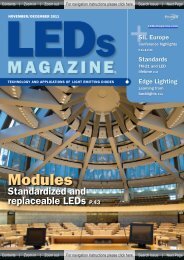Zoom In - Beriled
Zoom In - Beriled
Zoom In - Beriled
- No tags were found...
You also want an ePaper? Increase the reach of your titles
YUMPU automatically turns print PDFs into web optimized ePapers that Google loves.
Previous Page | Contents | <strong>Zoom</strong> in | <strong>Zoom</strong> out | Front Cover | Search Issue | Next PageABE FMaGSlighting | DIMMINGdimming is an essential part of any goodlighting solution, and understood some ofthe critical terms (see p. 22), the next step isto gain awareness of what types of dimmingcontrols currently exist. Selecting the appropriatecontrol depends on the light source,the degree of flexibility needed in the space,and whether an interface (ballast, driver, ortransformer) is needed. Below is an overviewof each of the main control types that existtoday, indicating where they are most commonlyused:a) Two-wire controlTwo-wire control is the most commonlyused control method today, and simply indicatesthat there is a single wire between thedevice and the light source. It is the controltype of a standard light switch, where powercomes into the switch through one wireand leaves through another. Within twowirecontrol there are two different controlmethodologies:i) Forward phase control: The more prominentof the two, it is also called leading-edgecontrol. <strong>In</strong> this control scheme the controlbegins each half-cycle in the open positionand then turns on and remains on for theremainder of the half-cycle. This is illustratedin Fig. 1a, where the light blue showswhen the control is open (off) and the darkblue shows when the control is closed (on).This method works well for controllinginductive loads, and as a result forwardphase control is required to control magneticlow-voltage lighting transformers. Itis also the dominant method used to controlincandescent lights.ii) Reverse phase control: Also called trailing-edgecontrol, it is used to control electroniclow-voltage light sources. As shown inFig. 1b, this is the exact opposite of forwardphase control. While this control type can beused on incandescent lights it typically providesthe ideal control signal for capacitiveloads, such as many LED drivers.b) Three-wire controlsThree-wire controls are primarily used tocontrol fluorescent light sources becausethe power requirements of the ballast willnot impact the dimming performance ofthe light source. One of the wires providespower to the light source whenever it is on,regardless of the light level, while the otherwire provides the control signal that setsthe light level at which the fixture should beoperating.<strong>In</strong> all of the following approaches (0-10V,DALI, and DMX), the control exists on an isolatedlow voltage link from the power to thelight source. One of the benefits of this is thatthe system can be interfaced with a varietyof other devices such as occupancy sensors,daylight sensors, and infrared receivers.c) 0-10V control0-10V control is an analog control that setsthe voltage to the light source between 0V(minimum light output) and 10V (maximumlight output). IEC standard 60929 specifiesexactly what control requirements exist forthis control type.d) Digital controli) DALI: This Digital Addressable Lighting<strong>In</strong>terface control standard, which emergedfrom Europe, allows for digital control ofseparate fixtures. This added level of controlprovides increased space flexibility,especially in commercial spaces.ii) DMX: This digital control type camefrom theater lighting control, and allowsfor multiple channels of light (both colorand intensity) to be controlled. It is typicallyused when trying to achieve complicatedlighting effects such as LED colormixing.ConclusionLEDs are a promising new light source forgeneral illumination, but they will neverexcel unless manufacturers understandconsumer expectations. Having control is abasic human desire, and lighting is no exception.Stereos would be limited without volumecontrols; ovens would be dysfunctionalwithout temperature controls, so why shouldlights be used without controls?24 APRIL 2009 LEDsmagazine.comPrevious Page | Contents | <strong>Zoom</strong> in | <strong>Zoom</strong> out | Front Cover | Search Issue | Next PageABE FMaGS

















